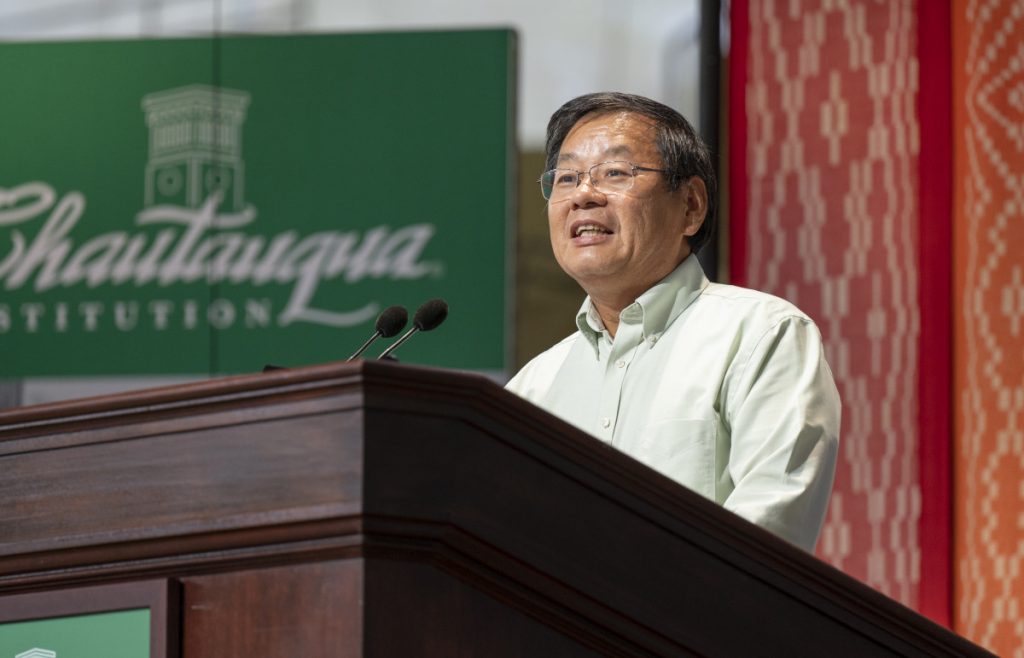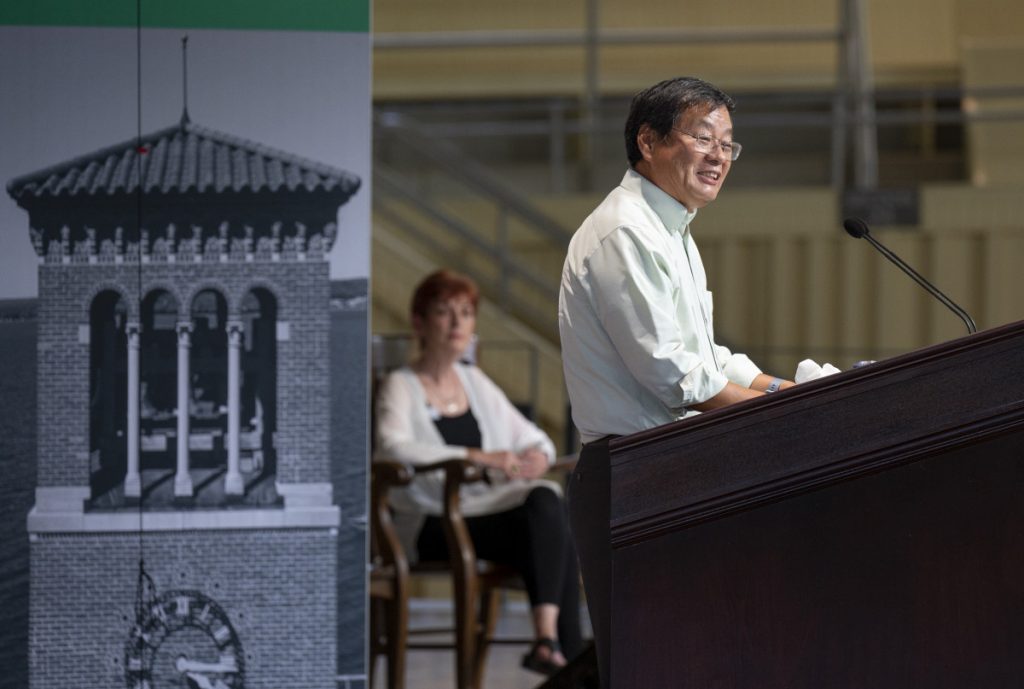MAX ZAMBRANO – STAFF WRITER

Fenggang Yang understands that Americans may not realize that millions of Chinese have turned to religion for decades.
It might be hard to believe because of Chinese Communist Party’s suppression of religion, he said, or because Americans usually focus on Chinese economy instead of Chinese faith beliefs.
Similar to a great religious awakening that occurred in the U.S. in the late 19th and early 20th centuries, where people would gather in camps for revival meetings and swarm churches for salvation and renewal — like with Chautauqua’s founding — China is in its own great awakening.
At 1 p.m. Tuesday in the Amphitheater, Yang presented his lecture, “The Changing Religious Landscape in Modernizing China,” part of the Week One Interfaith Lecture Series, “21st Century Religion in China: Collaboration, Competition, Confrontation?”
Alternatively, Yang said his lecture could be called “The Great Awakening in China.”
Yang is a sociology professor and founding director of the Center on Religion and the Global East at Purdue University. He is also the author of Religion in China: Survival and Revival under Communist Rule and Atlas of Religion in China: Social and Geographical Contexts.
Since President Xi Jinping came to power in 2012, Yang said China has shifted back toward its first 30 years after World War II, when Chairman Mao Zedong was in power and stifled religious freedom.
“It is returning to the old days,” Yang said. “Not the good old days, but the bad old days. I personally experienced these bad old days.”
He said while he was growing up in China during the 1960s and ‘70s, religion was completely banned.
“Religious buildings were shut down,” he said. “Holy scriptures were burned. Sacred statues were smashed. Monks and nuns were forced to return to secular life.”
Communist Albania was the only other country to ban religion, Yang said.

Yang grew up atheist. In fact, it was taught to students starting in elementary school, he said. People were taught religion was for the weak, he said, and they should find satisfaction in material wealth and cultural richness.
Instead, people were taught to respect Chairman Mao.
“In high school, we had an English class, and the first sentence we were taught to say was, ‘Long live Chairman Mao,’ ” Yang said.
Every aspect of Chinese life centered around Mao. Morning and evening prayers were said in front of a statue or picture of Mao. There were songs and poems dedicated to him, often in the Little Red Book, which was one of the only books people could get in China. Soon after Yang learned the English chant, however, Mao died.
“How magical the English language is,” Yang said.
Before Mao’s death in 1976, Yang had never heard of universities because they were all closed, like religious venues, he said. Yang went to university in 1978; one year later, religious services were allowed to resume.
Yang was drawn to philosophy in school, and he realized nearly all philosophers made important references to God. He was originally drawn to logos in Greek philosophy, and then came to learn through Christianity that logos represented God.
Like his own awakening, Yang said people in the 1980s began to have their awakenings.
Yang described several encounters he had with people who were religious before the Cultural Revolution who then returned to religion. One of those people was his father, who was a lifelong Chinese Communist Party member. It took time, however, for his father to warm up to religion.
“When I first told him that someday I might become a Christian, he reacted strongly,” Yang said. “He said, ‘If you do that, that would mean betraying me.’ ”
As it turned out, Yang’s father had a near-death experience when he rode his bike over an icy river that cracked open, swallowing him below. Yang said his father remembers being guided by a figure in white garments back toward the surface. It wasn’t until his father began exploring spirituality, after 1984, that he believed it was Jesus who guided him.
It wasn’t just the older population turning to religion, but young people, too, Yang said. The Tiananmen Square massacre on June 4, 1989, a brutal and deadly end to the Chinese Student Movement, was a major turning point.
“That was a watershed,” Yang said. “It was like a dam broke. The atheist dam broke open. People began to pour into churches and temples.”
He said he heard many stories of book clubs that wanted to read the Bible, but because it was difficult to interpret, they would find a Christian who could help them understand it, essentially turning these into Bible studies.
In summer 2000, Yang interviewed one person who said 100 people would gather at a specific McDonald’s each week to learn a Bible lesson. There would be nine different tables, and each week would be a new lesson led by American Christians. After two or three months, someone could go from not knowing anything about Christianity to becoming an evangelist.

“It’s very efficient, like the McDonald’s service of fast food,” Yang said.
Eventually, the police raided the McDonald’s, detaining each member of the group (oddly enough, the American leaders didn’t show up that day), Yang said. It was illegal to hold religious gatherings outside of specific government-designated venues.
The group agreed not to meet at that McDonald’s again, Yang said, which fooled the police because the group would just meet at another McDonald’s or restaurant from that point forward.
Yang met many young people who turned to all different religions, from a philosophy graduate student-turned-Buddhist monk to a descendant of Confucius becoming an imam, or Muslim leader. He knew other young people who turned to Confucianism or Taoism.
Christianity has been the fastest-growing religion in China, he said. Over the last 21 years, Yang has interviewed hundreds of people — entrepreneurs, academics, young professionals, lawyers, journalists, writers and artists — who are now Christian.
To explain, he compared religion to an economic market, which needs demand and supply, he said. In China, there are five legal religions: Buddhism, Islam, Taoism, Catholicism and Protestantism (although Catholicism and Protestantism are generally both considered Christian, China lists them as two separate religions).
“These religions are in what I would call the red market,” Yang said. “They are legally allowed and tolerated, but they are stained red — the Chinese Communist color.”
Churches have increased in number, but they are under some government control, Yang said. To make themselves more visible, churches would construct large, neon crosses, he said.
This made a communist party boss in Shanghai upset, Yang said, and between 2014 and 2016, more than 1,500 crosses were removed. Church services continued as normal, though.
Yang noted two other religious markets in China: black and gray. The black market consists of about 20 banned religions that still continue sneakily to avoid the watchful eye of the Chinese Communist Party.
The gray market is a middle ground of legal and illegal religious activity. For example, Yang said it is illegal to worship outside of designated venues, but people could regularly get away with worshiping inside of their own homes.
“By 2030, there could be more Christians in China than in the U.S. While it’s under suppression, it could take more than 10 or 20 years, but it’s uncontainable.”
Fenggang Yang, Founding Director, Center on Religion and the Global East
He calls these jiating (family, home or house in Chinese) churches.
“In the early history of Christianity, many Christians had to meet at people’s private homes,” Yang said. “Jiating churches have become more than that. Some have become large congregations with several hundred or more than a thousand people. Some of those congregations began to form together to create denominations.”
The main reason people meet in these jiating churches instead of regular churches is to avoid government-designated buildings, which they fear are controlled by the Communist Party, Yang said.
People would even worship in the streets and public squares, Yang said. Punishments are not severe — often no more than 24 hours in jail, and a couple of weeks at worst, he said.
“As soon as they were released, they would go back to the streets and squares,” he said. “They are so fired up, it’s uncontainable.”
It’s impossible to know exactly how many people identify with a certain religion in China because every organization comes up with a different number, Yang said. Furthermore, the government usually gives the smallest number possible and mission groups provide the highest number possible. As a sociologist, he said he presents a more conservative estimate.
His numbers show a dramatic increase in Protestantism in China, which began rising even when religion was banned during the Cultural Revolution. Between 1956 and 1982, for example, China went from less than 1 million Protestants to about 3 million, he said. The official government number today is 40 million, which he emphasizes again is certainly an undercount.
Yang said the higher estimate put the number of Chinese Christians over 100 million. The U.S. population is 331.5 million, according to the 2020 Census.

“At the same time, in the U.S., we know the proportion of Christians is declining,” Yang said. “By 2030, there could be more Christians in China than in the U.S. While it’s under suppression, it could take more than 10 or 20 years, but it’s uncontainable.”
Sharing maps from his atlas, Yang showed how widespread the five legally allowed religions are in China, with official venues spread across the country, significant for the world’s third-largest country by land area and largest by population.
One map showed which religion had the most venues for each province. In a high number of provinces, there were more Christian churches than any other religious venue.
Yang concluded his lecture drawing points from Week One’s theme. He said China is planning on sending out 20,000 missionaries by 2030, but they could use collaboration with experienced American Christian missionaries.
He acknowledges, however, ideological competition between China and the U.S.; between communism and democracy. The U.S. government will continue to confront China on its human rights violations especially concerning religious freedom, Yang said.
“We Americans believe that life, liberty and the pursuit of happiness are inalienable rights endowed by the creator,” he said. “In this globalization era, if we do not fight for this globally, we may lose them here, as well.”




